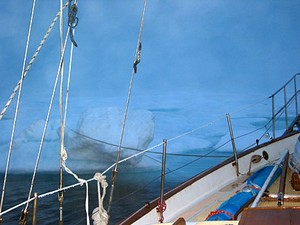Through the North West Passage with Fiona
by Log Fiona/Sail-World Cruising on 14 Dec 2009

Fiona tethered to iceberg.JPG SW
Among the 23 vessels that transited the North West Passage this year were two cruise ships, several power boats, some rowers, ice catamarans, and about seven hardy sailing boats.
Among the sailors was veteran long range cruising sailor Eric Forsyth, on his yacht Fiona, a Westerly 42, who completed the journey from East to West.
Here we bring you story highlights and photos of the challenging voyage.
Eric logged 8,873 nautical miles in 124 days departing Long Island on June 15 and arriving San Francisco on October 17. Eric and his crew averaged 112 miles per sailing day. Eric, at 77, will complete a circumnavigation of North America in May of 2010.
At one point in the journey they were trapped in ice, and, according to the Canadian Coast Guard 'were thinking about leaving the boat.'
Here is the incident as related by Eric:
' We pushed on for nearly twelve hours before we had to admit we were stuck and we tied ourselves to an iceberg just before midnight, although the light from a watery sun illuminated the fog and the gloomy scene around us.
I was awakened by a crash and the sudden tilting of my bunk. We all rushed on deck; a berg had collided with our own icy haven, it had rotated and the underwater mass had lifted Fiona's bow clear of the surface. With the stern still in deep water I started the engine, put the transmission in reverse and we slid back into the sea as though we were on ways.
We found another floe to attach ourselves to on the lee side using the dinghy anchor; one piece of equipment I had omitted to bring was a four-pronged grapnel. The fog started to lift and soon the shore of the Boothia Peninsula was visible just less than half a mile to the east. It looked rocky and very bleak.
A check of our position on the GPS showed that we were moving north with ice-field. We were still in a clear pool of water but it was shrinking, by lunchtime clear water had virtually disappeared and we were surrounded by ice, some of which was obviously 'old' ice with thick pieces tilted up on edge.
After lunch I checked our progress north in the field, we were heading back towards the Tasmanias at about 7 nautical miles a day. The chart showed a promontory and bay on the coast just before the islands, I was concerned the ice may push us into them.
I decided to call the Canadian coast Guard to advise them of our position and see if there was an ice breaker in the vicinity. I told them we were not in immediate danger and they advised getting the inflatable ready so that we could reach the shore of the Boothia Peninsula if Fiona was crushed and sank.'
You can read the entire log of the Fiona's passage by clicking http://www.yachtfiona.com/northwestpassage2009/newsletter1.html!HERE.
Eric has long been recognised as an adventurous cruising sailor, embarking on challenging journeys and displaying great seamanship. In January, 2001, he was awarded the prestigious Blue Water Medal of the Cruising Club of America. The citation reads:
'The Blue Water Medal for 2000 is awarded to Eric B. Forsyth for a remarkable voyage in his 42 ft sloop to Antarctica from his
home port at Patchogue, Long Island via the Panama Canal; Galapagos; Easter Island, Puerto Montt, Chile, and after Port Lockroy on the Antarctic Peninsular to South Georgia Island; Tristan da Cunha; South Africa, and returning home by way of St. Helena, Barbados, St. Martin and Bermuda. This was a 21,784 mile voyage, completed in ten months with a crew that varied between one and two young men. Furthermore, Forsyth wrote copious descriptions of his entire cruise including a special guide to the Patagonian passages, including mileage of each segment, fuel consumption, and all the features of the land and nature encountered.'
Then, in November 2007, Eric was awarded the Seven Seas Award by the Seven Seas Cruising Association. The citation reads, 'Signifying the highest international recognition of a cruising sailor whose experience on the sea demonstrates a deep commitment to good seamanship, and an understanding of his ship and the environment.'
If you want to link to this article then please use this URL: www.sail-world.com/64399